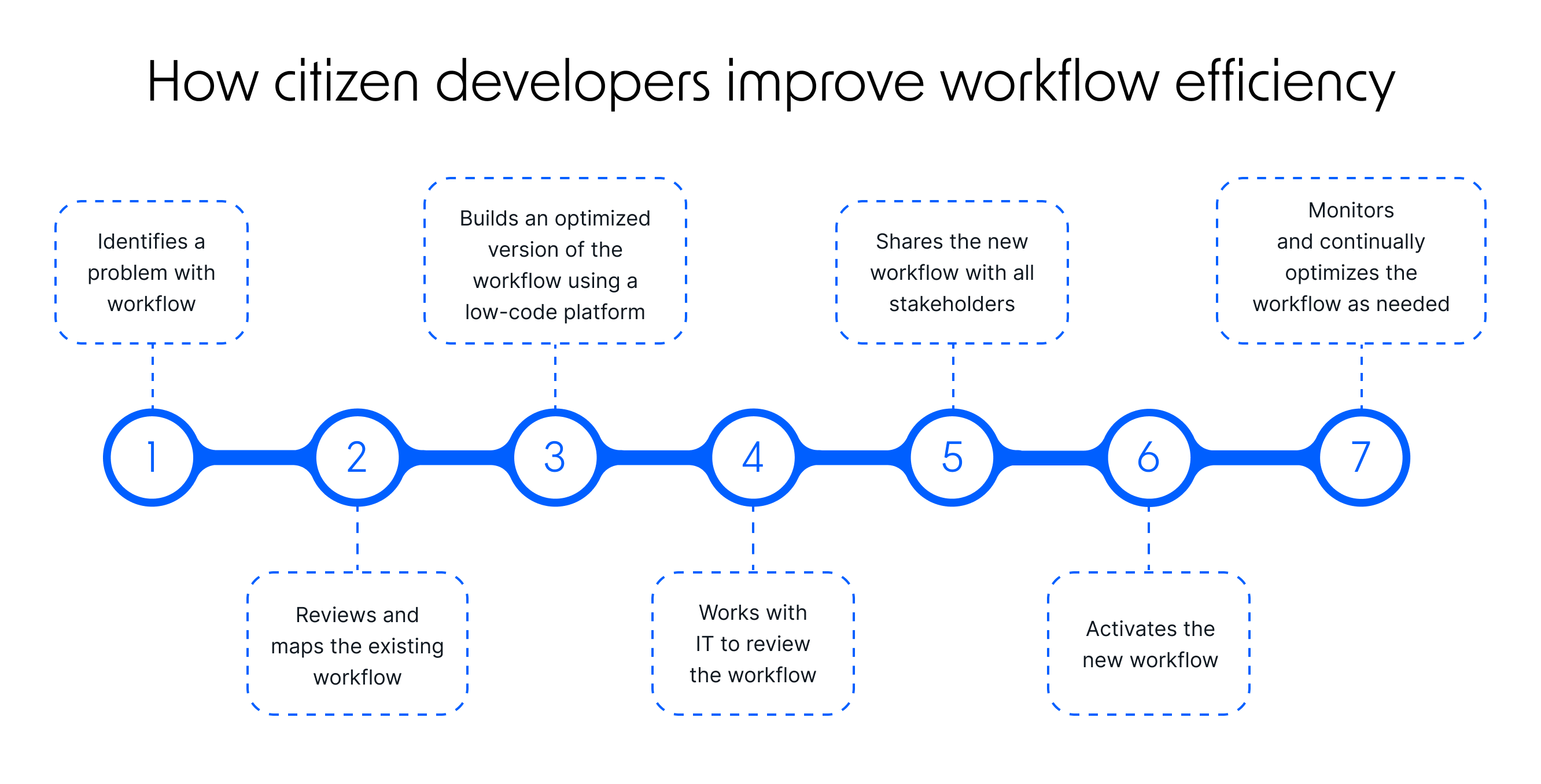
Chances are you’ve already heard about citizen developers. Over the past couple of years, citizen development — and its relative citizen automation — have taken center stage as businesses look for ways to improve efficiency, accelerate development cycles, and bridge the gap between business units and IT teams.
If you’re ready to start down the path to becoming a citizen developer, this guide is for you. Below, we’ll define what citizen development is, review the key terms and concepts of citizen development, and show you how to get started on the path to improving your company’s operational efficiency by identifying problems and developing solutions.
The Citizen Developer’s Guide to Workflow OptimizationDownload now
What is citizen development?
Citizen development is a model for building solutions and optimizing workflows in which business team members — those without coding experience — use software to solve problems and improve operational efficiency for their teams.
Who can be a citizen developer?
With the right tools, anyone can be a citizen developer.
A citizen developer is someone without coding experience who builds solutions — typically apps or workflows — using low-code (or no-code) software. Citizen developers are business-side team members who are deeply familiar with the challenges and inefficiencies their teams face. Citizen developers take the initiative to solve these problems and inefficiencies and then work with the IT team to ensure that the new app or workflow meets security standards.

Why are citizen developers important?
Citizen developers give businesses several strategic advantages. These include:
1 – Conserving IT resources and reducing the IT backlog
One of the most important benefits of citizen developers is that they reduce the amount of work for the IT team. Using IT-sanctioned low-code software, citizen developers help prevent situations in which every change request or need for a solution gets thrown over the wall to IT. By giving citizen developers the right tools, businesses invite qualified team members into the problem-solving process.
This is especially important given the ongoing shortage of software developers. According to Forrester Research, by 2024 the U.S. will see a shortage of 500,000 software developers. Citizen developers can help close that gap.
2 – Speeding up development cycles for new apps and workflows
According to the Project Management Institute (PMI), one of the benefits of citizen development is that it helps companies move from agile to hyper agile models of development. As PMI puts it:
Citizen development enables a “hyper-agile” way of working, which can lead to substantial reductions in cost and development times. With citizen development, the speed at which you can take an idea and design, build, test and deploy apps enables teams and organizations to deliver projects and bring products and services to market faster than ever before.
In other words, citizen developers help business teams solve problems more quickly and efficiently than traditional development methods. Citizen developers can do this because 1) they understand the business side needs better than anyone and 2) because they harness the power of low-code software to build the solutions their teams require.
| 70% of new app development in enterprise organizations will use low-code or no-code technologies by 2025. This is higher than >25% in 2020. By 2024, 65% of application development activity will already be low-code application development. – ©Gartner, 2021 |
3 – Improving operational efficiency
Operational efficiency is the watchword in today’s economy, and citizen developers play a key role in reducing time-to-value and the overall costs and time needed to deliver solutions. Because they also ease the burden on IT teams, citizen developers help companies ensure that their IT teams have more time for higher priorities, such as enforcing security, managing complex builds, and ensuring compliance across the enterprise.
4 – Enhancing collaboration between business and IT teams
One of the challenges many teams face is the gap between business and IT teams. Business teams understand the challenges and problems in their workflows, and IT teams know how to build solutions. Citizen developers are business team members who have their hands on the work and who truly understand the challenges their teams face. Citizen developers bring this expertise into the problem-solving process to ensure that apps and workflows are a good fit for the business need.
5 – Improving business agility
With the right tools, citizen developers can build workflows and apps that respond to customer feedback, competitor activity, and emerging challenges faster than ever before.
How to become a citizen developer
| See if your company has a citizen developer initiative | According to Gartner, 41% of companies surveyed indicated that they have active citizen developer initiatives. Another 20% were evaluating or planning to start a citizen developer initiative. |
| If not, talk to your leadership about becoming a citizen developer | Citizen developers are those who take the initiative to solve problems with workflows or create solutions to their teams’ problems. Reach out to your leadership and let them know you are interested in building your skills as a citizen developer. |
| Find the right tools for the job | Because most citizen developers don’t have traditional coding experience, it’s important to have the tools that enable them to do their jobs. This is where low-code (sometimes called no-code) software comes in. Low-code platforms require no coding skills. Instead, citizen developers use an intuitive interface (such as drag-and-drop) to build the workflows and solutions they need. |
| Learn to use the tools | Get familiar with the low-code tool you’ve decided to use. Understand its interface, features, and capabilities. When you’re ready, it’s time to start building solutions. |
| Identify solution opportunities | Determine the needs for your team. Is it a new app that needs to be created? Or is it a workflow that needs optimization? This is the time to get in the weeds with your problem so you can figure out how to solve it. |
| Start developing | Use your low-code software solution to build the solution. |
| Develop a relationship with IT | Any low-code tool you use will be approved and managed by your IT team. You’ll want to make sure that the solutions you are building make sense for the IT team, and that your solution meets security and compliance requirements. Having a good relationship with your IT team can make it easier (and faster) to get your project over the finish line. |
Best practices for citizen development
Citizen development can help your company develop solutions and optimize workflows more efficiently and quickly than ever before. Here are some best practices to follow as you continue on your citizen developer journey:
- Take the time to truly understand the problem you are going to solve.
- Identify all stakeholders and secure their buy-in.
- Check for alignment with business strategy.
- Build a strong rapport with your IT team.
- Select a low-code tool that is appropriate for your work and which integrates easily with your existing stack.
- Document your development plan or workflow optimization for future reference.
- Communicate changes to all stakeholders.
Pipefy is built for citizen developers
Pipefy is the low-code platform that citizen developers like you rely on to solve workflow and process problems everyday. Pipefy is intuitive and easy-to-use: there’s no steep learning curve to slow you down. Pipefy integrates with your existing stack and extends its capabilities by solving process gaps and eliminating data silos.
With a range of features, capabilities, and built-in security, Pipefy accelerates citizen development initiatives and amplifies operational efficiency across the enterprise, from Finance and HR, to IT and Customer Ops.










